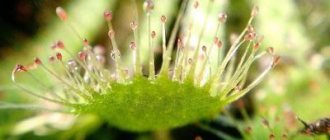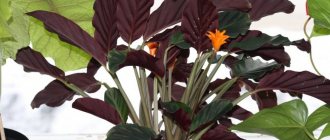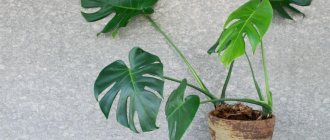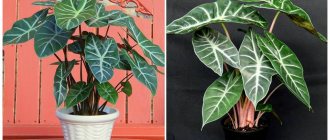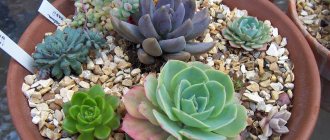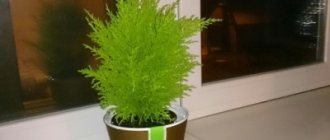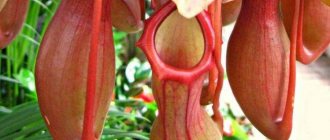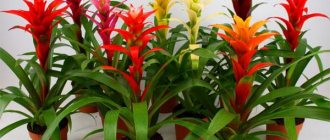Zebrina is a species of Tradescantia, a plant belonging to the Commelinaceae family. Zebrina is bred in homes and offices due to its ease of care. Its homeland is Mexico and Central America.
Zebrina is popular as a houseplant primarily due to its intricate colors, which vary depending on the species, but are distinguished by a characteristic feature: stripes along the leaves.
In any photo of a zebra, these stripes are clearly visible.
Botanical description
Zebrina is an independent species of the Cammeline family native to Central America and Mexico. Some plant growers mistakenly confuse it with Tradescantia, since the plant belonged to this genus until recently. At the same time, the zebrafish has many differences, especially in appearance. This species has an unusual color of leaf blades, which creates an exotic appearance.
Zebrina is an ornamental perennial, but its flowering occurs extremely rarely.
The longitudinal stripes on the upper side of the leaves are silver, white, pale green, and purple. They run along the stripe of the main color, as if bending around it at the end of the leaves. The oval leaves are 6.5 cm long.
From April to August, tiny flowers appear on the bush, collected from 3 purple, pink or lilac petals. Unlike Tradescantia, this culture has a fused-leaved corolla and calyx. The buds bloom throughout the summer and are formed in the axils at the tops of the shoots.
Representatives of the species are characterized by rapid growth rates and a rapid increase in vegetative mass. In one season, young shoots that grow vertically upward gradually descend and become creeping.
Origin story
In the distant seventeenth century, John Tradescan served as the chief gardener for the English king Charles the First , and was also a scientist-researcher and traveler. At that time, the newly discovered continent of America was being actively studied, and a huge number of plants unknown in Europe required classification and naming.
Among this diversity, John's attention was drawn to an inconspicuous, creeping plant from the tropical forests. It did not have beautiful flowers, but was distinguished by its unpretentiousness and rapid growth.
Tradescan realized that this plant had wonderful prospects and took a serious approach to its cultivation and cultivation.
Among the many indoor plants, few people do not recognize this plant and call it by name, remembering him - the gardener Tradescana .
Hanging
It is the most common representative of the species. Hanging shoots form twists with little rooting.
The leaf blades are arranged in two rows and have an ovoid structure with an elongated upper part. Their length reaches 5-6.5 centimeters, and their width is about 3 cm. The leaves have a specific color, which is represented by two silver-white stripes on a red background on the outside and purple stripes on the bottom.
Single pink flowers are surrounded by two bracts with a whitish tint. The plants are found in rocky areas and near rivers in Mexico and Central America. They prefer a humid tropical climate.
You can see what the Zebrina Hanging variety looks like in the photo below:
Zebrina Hanging
Hanging four-color
It is characterized by a specific and lush color of the leaf blades. In the core area they are painted green with a metallic tint, and the frame consists of green-red and whitish stripes. The leaves have a purple tint at the bottom.
You can see what the Zebrina Four-Color variety looks like in the photo below:
Zebrina Quadricolor
Purpusa
Zebrina purpus differs from other species in the absence of pronounced stripes on the leaf blades. The leaves, like the shoot, have a similar reddish-olive-green color. On the front side there is a characteristic pubescence. The leaves are bare below and have a purple tint.
The length of the leaf blades varies from 8 to 10 cm, and the width is 3-5 cm. Zebrina purpusa grows in the Mexican savannas, in rocky areas at an altitude of 400-500 m above sea level. Prefers illuminated places.
In the photo below is the Zebrina Purpuza variety:
Zebrina Purpuza
Care
Growing zebrina at home is not difficult. It is enough to provide comfortable growing conditions and follow some rules.
Lighting
Zebrina belongs to the group of hanging plants that feel comfortable on individual stands or in hanging pots. The culture needs abundant lighting, so it is better to place it between two windows, where there is no lack of sunlight, but there is shading from direct rays of the sun, which negatively affect the condition of the flower.
The room in which the zebrafish is located requires regular ventilation.
Expert opinion
Victoria Goncharova
Specialized education: landscape designer, agronomist, gardener. Experience in caring for potted fresh flowers/plants at a professional level!
In summer, it is customary to take the flower out into the open or even plant it in a flowerbed, if the climatic conditions in the region allow this.
Temperature
Useful properties of zebrina
In addition to its aesthetic appeal, zebrina also has many beneficial properties. The healing qualities of this plant were known back in ancient times in Latin America. In Buddhist monasteries, zebrina was specially grown as a medicinal plant.
Zebrina juice contains substances that lower blood sugar levels. Zebrina juice is also characterized by antimicrobial activity because it contains phytoncides.
Zebrina leaves have an anti-inflammatory effect, so the back of them is sometimes applied to cuts and bruises.
Zebrina helps purify the air; due to this quality, it is often grown not only in apartments, but also in public places such as hospitals, offices or schools.
Recommended by topic
Aichrizon (Tree of Love) Cryptomeria Japanese Tradescantia Zebrina is a heat-loving decorative deciduous planting, therefore it reacts extremely negatively to severe cold snaps.
In summer, the optimal temperature in the room with the flower is 25-28 degrees Celsius. In winter it is reduced to 12-13 degrees Celsius. Also at this time, the length of daylight hours is reduced by moving the plant to a cooler room to slow down the growth and elongation of shoots. Otherwise, the decorative properties of the flower will decrease. If the temperature drops to 0, the root system of the crop does not die, but the color of the foliage turns pale and the overall appearance deteriorates. In the spring and summer, the zebrina begins the stage of active vegetation. The shoots begin to droop and hang down.
Humidity and watering
The substrate in a pot with zebrina should not be excessively dry, but also waterlogged.
In the first case, the weak root system will begin to be damaged. In this case, excess moisture will lead to rotting of both roots and ground shoots. Therefore, the soil mixture should be kept moderately moist. The fact that a flower requires watering can be determined by the condition of the top soil layer: if it is overdried by 2-3 cm, the procedure is mandatory. The intervals between watering are determined by the time of year - in the summer, zebrina needs to be watered more often and more intensively, in winter - less often.
There are no strict requirements regarding indoor air humidity, since it does not have a particular impact on the development of the crop. But preventive spraying and a warm shower will be useful.
Zebrina is characterized by increased resistance to infrequent watering and dry growing conditions, but such phenomena are extremely undesirable. Watering the flower is carried out at the root using soft, settled water at room temperature.
Top dressing
Like other decorative flowers, zebrina needs proper and timely feeding, which is done every two weeks from March until the end of autumn. Complex preparations for decorative foliage plants are used as fertilizers.
Among them:
Agricola
Sodium humate
A drop
leaf
Lignohumate
You can also use the listed drugs together with watering, adding them to the water. But the main thing is to follow the recommended dosage and not allow an excess of nutrients in the soil. Otherwise, the state of the culture will deteriorate.
In autumn and winter, when the flower begins its dormant stage, it is not necessary to feed it. Also, fertilizing is not needed after replanting the flower into a new pot, or in the presence of diseases.
Organic components are added in small quantities, since their excess can cause the disappearance of stripes on the leaves.
Transfer
to transplant zebrina only after purchasing it in a store. But before this, the plant must adapt to new growing conditions (this will take about 1.5-2 weeks).
Also, replanting work is needed if there is not enough space in the old pot. The new container is selected a few centimeters wider than the previous one and slightly higher. Since representatives of the species are characterized by accelerated growth rates, young specimens are replanted once a year.
The most favorable time for such actions is early spring, before the crop begins to actively grow green mass.
Priming
You can prepare a mixture for growing zebrina with your own hands by combining the following components in proportions 1:1:1:1:
Humus soil
Peat land
Sod land
Sand
To the listed ingredients add 2 parts of leaf soil. Some gardeners have successfully grown zebrina hydroponically (a soilless principle), where important elements are absorbed in the right quantities from the solution.
Wintering
Between October and March, zebrina goes into a dormant state. During this period, the frequency of watering is reduced to a minimum (2 times a week), and the application of fertilizers is completely stopped.
Temperature
A comfortable temperature regime for Tradescantia will be from +20 to +24 C. Also in the cool autumn-winter period, it can withstand up to +130 C, but not lower. Try to water and spray the plant regularly.
The active period falls in spring and summer, during which time Zebrina grows and gains weight. The opposite is the winter period; the plant requires moderate watering, comfortable temperatures and proper care.
Reproduction
There are several effective methods for propagating zebrina, which are used by gardeners when growing the crop at home.
Cuttings
Cuttings are considered the simplest and most effective propagation method.
To carry out the procedure, planting cuttings 16-19 cm long with several leaves on each are cut from long shoots.
Then the planting material is placed in a container of water with the addition of a root growth stimulator (Kornevin is suitable).
After 2-4 weeks, light roots will appear at the bottom of the cuttings. This indicates the possibility of transplanting them into separate pots. One container can contain up to 3 cuttings.
Seeds
The seed propagation method is considered the most difficult. To do this, seed material is placed in a container with fertile soil and distributed evenly over the surface. Then the crops are covered with polyethylene or glass. From time to time the cover is removed to moisten the soil from the sprayer.
When the first shoots appear, the glass is removed. After the formation of 2 pairs of true leaves, the procedure of picking seedlings into separate pots is performed. Watering young flowers is done strictly at the root.
By division
If the plant has grown greatly, you can propagate it by dividing the mother bush into several parts. It is recommended to carry out such actions in conjunction with replanting work so as not to harm the root system.
Each division is placed in a separate pot and shaded for several days. During rooting, flowers require moderate watering.
Diseases and pests
Zebrina is characterized by increased resistance to diseases and harmful insects. However, she is attacked:
Shields
Spider mite
Trips
Aphids make homes on young shoots, while other parasites prefer to live on both sides of leaf blades, causing their discoloration and inevitable death.
Pest control is carried out using insecticidal preparations with preliminary removal of pests from the leaf with a moistened sponge dipped in soap suds.
A prolonged lack of sunlight can cause the death of a flower. If the crop is located in twilight and its leaves have become pale, the pot should be immediately moved to the bright part of the room.
The appearance of white spots on the leaves indicates an excess of moisture. To solve the problem, it is enough to reduce the frequency of watering.
Also, when growing zebrina, you may encounter the following problems:
- Falling leaves. This happens when the zebrafish becomes too old. Therefore, the falling and yellowing of leaves is a natural process. Less often, waterlogging of the soil during watering causes problems.
- Loss of decorative properties. The problem occurs when there is a lack of sunlight, due to which the leaf plates lose multi-colored pigments and become monochromatic. Try changing the location of the pot, and after some time the foliage will become beautiful again.
- Rotting of shoots. Stem rot develops against the background of waterlogging of the substrate. To get rid of it, you should stop watering for several weeks, and then carefully monitor the condition of the upper soil layers.
- The stems become bare. This happens against the background of natural aging of the crop, lack of lighting and moisture, as well as a lack of nutritional components in the soil.
- The leaves wrinkle and turn brown. The problem is caused by a lack of humidity in the room. To prevent it, you need to humidify the air in the room with the flower several times a day.
- Growth stops and the flower begins to fade. Similar symptoms appear when a plant is infested with spider mites. The fight is carried out with insecticides, for example, Fitoverm or Aktellik.
If you follow the basic rules of care, the listed troubles will not bother your zebra.
Possible problems
If the Tradescantia room begins to look different than usual, then pay attention to the care and eliminate the mistakes made.
- The shoots are bare, there are few leaves: the plant lacks water and nutrients;
- Leaves have lost their color: not enough light;
- wilted, yellowed leaves: due to lack of moisture;
- The tips of the leaves dry out: the room is too dry;
- Drooping, thinning leaves become watery: the soil is swampy or excessively dry. If the soil is dry, watering will save the tridescantia, but prolonged moisture can lead to problems with the roots. In this case, it is best to cut off the shoots and root them in a new container.
